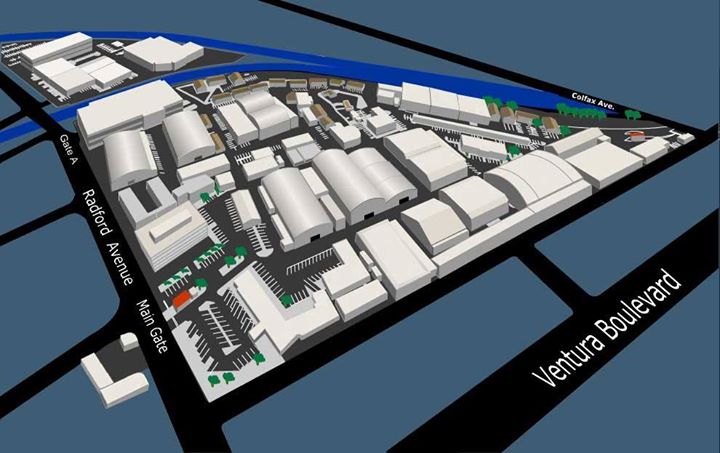In The Beginning…CBS STUDIO CITY
In The Beginning…CBS STUDIO CITY
Below left is the original property as it looked in 1926 as the Mack Sennett Studios. On the left, a rendering of how it looks now and at the link, a guided tour via an animated map. Here’s the history. http://www.cbssc.com/map.htm
The year was 1926 and plans for a new city in the San Fernando Valley were being developed. It began with the purchase of a 50 acre lettuce ranch at the corner of Colfax Avenue and Ventura Boulevard, along with a 300 acre ranch located at Laurel Canyon. During this time, “King of Comedy” Mack Sennett, known for his two-reelers and the Keystone Kops, was looking for a new studio location. A deal was struck and in 1928 Mack Sennett Studios opened and the surrounding area became known as Studio City. At this time the Studio consisted of one office building, a projection room/film editing building, a film library, a two-story dressing room building attached to a large sound stage, a wardrobe building, garage, and a stage with an inground swimming pool. With the advent of sound in 1929, Sennett was the first producer to use RCA equipment, with which he produced a bunch of singing short subject films with a young unknown named Bing Crosby.
In 1933 the Great Depression forced Sennett into bankruptcy and the Studio became an independent production facility. Mascot Pictures, under the direction of Nat Levine, became one of the principle tenants and for the next two years the Studio was known as Mascot Studios. Mascot produced the Saturday matinee serial which always ended with the heroine left tied to the railroad tracks as a speeding train came hurtling toward, interrupted by “continued next week.”
In 1935 Mascot Pictures, Monogram Pictures and Consolidated Film Industries joined with several other independent producers and became known as Republic Studios. By then there were six sound stages and several more support buildings. Republic produced over fifty features a year which starred, among others, legends Roy Rogers, John Wayne, Joan Crawford and Barbara Stanwyck. With the advent of television in the early 1950’s, Republic entered a new medium and produced a number of series. By this time there were twenty-three sound stages and the largest scoring studio in the world.
In 1963 the CBS Television Network entered into an agreement with Republic Studios whereby CBS became the major lessee and the facility was renamed CBS Studio Center. By 1967 CBS decided to purchase the studio and long range improvement plans began. The lot continued to grow and throughout the 60’s and 70’s such television classics as Gunsmoke, Big Valley, Gilligan’s Island, Get Smart, My Three Sons, Bob Newhart, and Mary Tyler Moore were produced at the Studio.
In July of 1982 CBS and 20th Century Fox Film Corporation formed a joint venture which included ownership and operation of CBS Studio Center, and for the first time in almost twenty years a new name appeared on the sign above the main gate, CBS/Fox Studios. Then in 1984 Fox sold its interest in the Studio to MTM Enterprises and the facility became CBS/MTM Studios. Shows produced on the lot during the 80’s included Roseanne, Different World, Thirtysomething, St. Elsewhere, Newhart, Hill Street Blues and Falcon Crest.
CBS acquired MTM’s interest in the Studio in 1992 and once again the CBS Studio Center sign appeared at the gate. Seinfeld, Grace Under Fire, 3rd Rock from the Sun, Cybill, and Caroline in the City are just a few of the shows which called CBS Studio Center home during the 90’s. Features such as Father of the Bride 2, Dr. Doolittle, and I Love Trouble were also filmed on the Studio lot.
Some of the more recent hit shows produced on the lot of CBS Studio Center are, CSI:NY, The Defenders, The Talk, Hot in Cleveland, According to Jim, Will & Grace, Big Brother and That 70’s Show.
Today the Studio continues to flourish and grow. CBS Studio Center is now home to a brand new Broadcast Center which houses CBS2 and KCAL9.

It’s also home to Big Brother… sighhhhh.
I saw this web site and I got the impression that Studio City was much smaller than I thought it was, which kind of surprised me. But seeing this, I can see that I obviously didn’t explore enough. By the way, whoever put the site together, did a fantastic job.
In Hollywood today it is often referred to as “The Radford Lot” since it is boarded on its main gate side by Radford Avenue.
Thanks again for all the interesting and historic details.
I love these stories.
Great story. Love these tidbits of history.